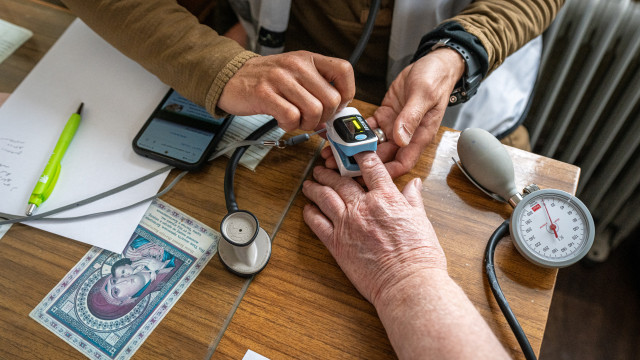



























See Also
See Again
© Shutterstock
0 / 28 Fotos
Is the 30-30-30 a diet plan?
- The 30-30-30 diet plan isn't a traditional diet. It's more of a guide to starting your day successfully.
© Shutterstock
1 / 28 Fotos
What is the 30-30-30 diet?
- With the 30-30-30 plan, you should eat 30 grams of protein within 30 minutes of waking up followed by 30 minutes of steady state cardiovascular exercise.
© Shutterstock
2 / 28 Fotos
How has It gained popularity?
- Author Tim Ferriss develop the diet for his book called 'The 4-Hour Body.' However, the online buzz came predominately from biologist Gary Brecka on TikTok who coined the steady state cardiovascular exercise terminology.
© Shutterstock
3 / 28 Fotos
Scientific basis of high protein breakfasts
- Despite many TikTok users claiming the diet can help with weight loss, it hasn't been formally studied. Therefore, there's no hard evidence to back up the claims.
© Shutterstock
4 / 28 Fotos
Why the 30-30-30 diet may work
- The 30-30-30 diet may work if it interests you and you feel confident you can stick to it.
© Shutterstock
5 / 28 Fotos
Why protein in the morning is important - The diet suggests that by eating protein in the morning, you may eat less in general later throughout the day, potentially leading to a calorie deficit and long-term weight loss.
© Getty Images
6 / 28 Fotos
Detailed guidance on protein choices
- Breakfast ideas that are packed with protein include eggs, Greek yogurt, tofu scrambles, or protein shakes. You can choose options that align with your dietary preferences such as plant-based, gluten-free, or dairy-free.
© Shutterstock
7 / 28 Fotos
Study results on high protein breakfasts
- Research has linked breakfasts high in protein to benefits like improved blood pressure and higher HDL or good cholesterol.
© Shutterstock
8 / 28 Fotos
Morning exercise and physical activity guidelines
- Exercising early in the morning aligns well with the CDC's recommendations for weekly activity. They say that you should get 150 minutes of moderate-intensity activity and at least two strength training sessions a week.
© Shutterstock
9 / 28 Fotos
Steady state cardiovascular exercise
- Steady state cardiovascular exercises are low to moderate-intensity workouts that keep your heart steady (45-60% of maximum heart rate), improve fat oxidation, cardiovascular endurance, and contribute toward mental clarity.
© Shutterstock
10 / 28 Fotos
Ideas for morning 30-30-30 cardio activities
- Activities like biking, brisk walking, dancing, and using an elliptical are excellent options for steady state cardio.
© Shutterstock
11 / 28 Fotos
More examples of steady state cardio
- Other effective activities can include activities such as rowing and swimming.
© Shutterstock
12 / 28 Fotos
Alternatives for morning exercise routines
- If you can't or don't want to exercise in the morning, push yourself to do little bits of cardio throughout the day. One example is to take the stairs at work versus using the elevator.
© Shutterstock
13 / 28 Fotos
Additional benefits of the 30-30-30 diet
- The 30-30-30 routine helps jump-start your metabolism, improves blood flow, and helps you prioritize exercise before the work day gets too busy and you risk putting off exercise.
© Shutterstock
14 / 28 Fotos
Following the 30-30-30 diet and protein intake guidelines
- Protein needs can range from .8 to 1 gram per kilogram of body weight. However, it may be necessary to adjust for specific goals or health conditions.
© Shutterstock
15 / 28 Fotos
Potential risks and common missteps
- It's important to focus on balanced meals and wholesome foods instead of relying solely on processed proteins or neglecting other nutrients.
© Shutterstock
16 / 28 Fotos
Factors influencing how much protein you need
- Protein requirements can vary depending on weight, activity levels, and health goals.
© Shutterstock
17 / 28 Fotos
Potential downfall of the 30-30-30 diet
- The 30-30-30 diet or plan doesn't really have strict guidance. Therefore, if poor meal choices are made later in the day, it can reduce its effectiveness.
© Shutterstock
18 / 28 Fotos
Importance of healthy choices throughout the day
- Choosing healthy options throughout the day is extremely important in achieving balanced health.
© Shutterstock
19 / 28 Fotos
Incorporating the 30-30-30 plan into a holistic diet
- In order to reap the most benefits out of your diet, be sure to hydrate adequately. Be mindful of your eating and drinking choices.
© Shutterstock
20 / 28 Fotos
Is the 30-30-30 diet right for everyone?
- The 30-30-30 diet isn't the best option for every person. It's more effective for individuals who can prioritize a healthy morning routine.
© Shutterstock
21 / 28 Fotos
Challenges of eating first thing in the morning
- Eating 30 grams of protein immediately upon waking up can be a challenge for some people. If this sounds like you, try a gradual approach where you work your way up to eating to 30 grams.
© Shutterstock
22 / 28 Fotos
Tracking progress and setting goals
- It can be helpful to use a food or fitness journal to monitor your progress. Additionally, try to set realistic goals so you stay motivated.
© Shutterstock
23 / 28 Fotos
Safety considerations for specific health conditions
- While talking to a doctor or medical professional is usually a good idea before any new change in lifestyle, those with kidney or liver conditions should be extra aware.
© Shutterstock
24 / 28 Fotos
Professional advice for individuals with dietary restrictions or medical concerns
- Another option is to see a registered dietitian. Professionals can tailor the plan to fit unique dietary needs or health concerns.
© Shutterstock
25 / 28 Fotos
Comparison with other morning routines
- Other routines such as intermittent fasting or high-intensity interval training (HIIT) may have faster or better results when compared to the 30-30-30 diet plan.
© Shutterstock
26 / 28 Fotos
Cultural and demographic adaptations for the diet
- It's possible to adapt the 30-30-30 diet with local staples. The diet is also appealing for those of all ages, including students and the elderly. Sources: (Cleveland Clinic) (UCLA Health)
© Shutterstock
27 / 28 Fotos
© Shutterstock
0 / 28 Fotos
Is the 30-30-30 a diet plan?
- The 30-30-30 diet plan isn't a traditional diet. It's more of a guide to starting your day successfully.
© Shutterstock
1 / 28 Fotos
What is the 30-30-30 diet?
- With the 30-30-30 plan, you should eat 30 grams of protein within 30 minutes of waking up followed by 30 minutes of steady state cardiovascular exercise.
© Shutterstock
2 / 28 Fotos
How has It gained popularity?
- Author Tim Ferriss develop the diet for his book called 'The 4-Hour Body.' However, the online buzz came predominately from biologist Gary Brecka on TikTok who coined the steady state cardiovascular exercise terminology.
© Shutterstock
3 / 28 Fotos
Scientific basis of high protein breakfasts
- Despite many TikTok users claiming the diet can help with weight loss, it hasn't been formally studied. Therefore, there's no hard evidence to back up the claims.
© Shutterstock
4 / 28 Fotos
Why the 30-30-30 diet may work
- The 30-30-30 diet may work if it interests you and you feel confident you can stick to it.
© Shutterstock
5 / 28 Fotos
Why protein in the morning is important - The diet suggests that by eating protein in the morning, you may eat less in general later throughout the day, potentially leading to a calorie deficit and long-term weight loss.
© Getty Images
6 / 28 Fotos
Detailed guidance on protein choices
- Breakfast ideas that are packed with protein include eggs, Greek yogurt, tofu scrambles, or protein shakes. You can choose options that align with your dietary preferences such as plant-based, gluten-free, or dairy-free.
© Shutterstock
7 / 28 Fotos
Study results on high protein breakfasts
- Research has linked breakfasts high in protein to benefits like improved blood pressure and higher HDL or good cholesterol.
© Shutterstock
8 / 28 Fotos
Morning exercise and physical activity guidelines
- Exercising early in the morning aligns well with the CDC's recommendations for weekly activity. They say that you should get 150 minutes of moderate-intensity activity and at least two strength training sessions a week.
© Shutterstock
9 / 28 Fotos
Steady state cardiovascular exercise
- Steady state cardiovascular exercises are low to moderate-intensity workouts that keep your heart steady (45-60% of maximum heart rate), improve fat oxidation, cardiovascular endurance, and contribute toward mental clarity.
© Shutterstock
10 / 28 Fotos
Ideas for morning 30-30-30 cardio activities
- Activities like biking, brisk walking, dancing, and using an elliptical are excellent options for steady state cardio.
© Shutterstock
11 / 28 Fotos
More examples of steady state cardio
- Other effective activities can include activities such as rowing and swimming.
© Shutterstock
12 / 28 Fotos
Alternatives for morning exercise routines
- If you can't or don't want to exercise in the morning, push yourself to do little bits of cardio throughout the day. One example is to take the stairs at work versus using the elevator.
© Shutterstock
13 / 28 Fotos
Additional benefits of the 30-30-30 diet
- The 30-30-30 routine helps jump-start your metabolism, improves blood flow, and helps you prioritize exercise before the work day gets too busy and you risk putting off exercise.
© Shutterstock
14 / 28 Fotos
Following the 30-30-30 diet and protein intake guidelines
- Protein needs can range from .8 to 1 gram per kilogram of body weight. However, it may be necessary to adjust for specific goals or health conditions.
© Shutterstock
15 / 28 Fotos
Potential risks and common missteps
- It's important to focus on balanced meals and wholesome foods instead of relying solely on processed proteins or neglecting other nutrients.
© Shutterstock
16 / 28 Fotos
Factors influencing how much protein you need
- Protein requirements can vary depending on weight, activity levels, and health goals.
© Shutterstock
17 / 28 Fotos
Potential downfall of the 30-30-30 diet
- The 30-30-30 diet or plan doesn't really have strict guidance. Therefore, if poor meal choices are made later in the day, it can reduce its effectiveness.
© Shutterstock
18 / 28 Fotos
Importance of healthy choices throughout the day
- Choosing healthy options throughout the day is extremely important in achieving balanced health.
© Shutterstock
19 / 28 Fotos
Incorporating the 30-30-30 plan into a holistic diet
- In order to reap the most benefits out of your diet, be sure to hydrate adequately. Be mindful of your eating and drinking choices.
© Shutterstock
20 / 28 Fotos
Is the 30-30-30 diet right for everyone?
- The 30-30-30 diet isn't the best option for every person. It's more effective for individuals who can prioritize a healthy morning routine.
© Shutterstock
21 / 28 Fotos
Challenges of eating first thing in the morning
- Eating 30 grams of protein immediately upon waking up can be a challenge for some people. If this sounds like you, try a gradual approach where you work your way up to eating to 30 grams.
© Shutterstock
22 / 28 Fotos
Tracking progress and setting goals
- It can be helpful to use a food or fitness journal to monitor your progress. Additionally, try to set realistic goals so you stay motivated.
© Shutterstock
23 / 28 Fotos
Safety considerations for specific health conditions
- While talking to a doctor or medical professional is usually a good idea before any new change in lifestyle, those with kidney or liver conditions should be extra aware.
© Shutterstock
24 / 28 Fotos
Professional advice for individuals with dietary restrictions or medical concerns
- Another option is to see a registered dietitian. Professionals can tailor the plan to fit unique dietary needs or health concerns.
© Shutterstock
25 / 28 Fotos
Comparison with other morning routines
- Other routines such as intermittent fasting or high-intensity interval training (HIIT) may have faster or better results when compared to the 30-30-30 diet plan.
© Shutterstock
26 / 28 Fotos
Cultural and demographic adaptations for the diet
- It's possible to adapt the 30-30-30 diet with local staples. The diet is also appealing for those of all ages, including students and the elderly. Sources: (Cleveland Clinic) (UCLA Health)
© Shutterstock
27 / 28 Fotos
What is the 30-30-30 diet, and is it right for you?
Tips and insights you need to know
© Shutterstock
Have you heard of the trending 30-30-30 diet? This diet or plan has caught the attention of social media users across the globe and has sparked the curiosity of those seeking the next diet trend. So what is it? And does it really work? In this gallery, you'll find a guide with everything you need to know about the 30-30-30 diet and information to help you decide if it's right for you. From its core principles to potential health benefits, this plan has garnered attention for its balanced approach. Let’s dive into the details to see if it lives up to the hype.
Curious about the 30-30-30 diet? Click through now to explore more.
RECOMMENDED FOR YOU




























MOST READ
- Last Hour
- Last Day
- Last Week








